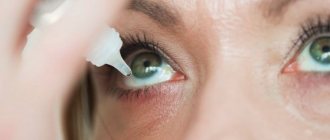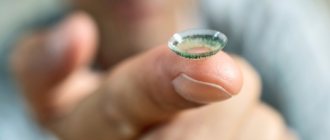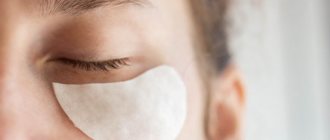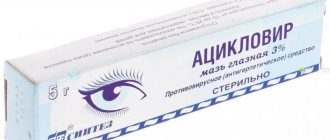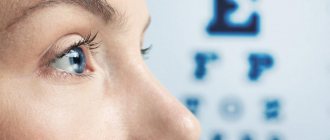How to treat blepharitis of the eyelids
Before using traditional medicine, you should get formal treatment from a doctor.
There is no need to give it up, because modern medications will allow you to quickly get rid of the disease. However, they have their consequences, and the treatment itself may take too long. It is also possible to cure blepharitis at home, and by combining the two complexes, the result will be much better and more effective. Moreover, home procedures are quite simple, and everyone can cope with them. It is important to do them systematically and not to miss them, no matter how difficult it may be. Many people do these procedures for a couple of days, see the result (and there will definitely be one), and give up, thinking that the body will then begin to heal itself. This is the biggest mistake. You should not stop these procedures until the results are complete.
Ointments for eyelids
You can treat blepharitis with folk remedies at home using homemade ointments. The simplest and most accessible recipe is a mixture of burdock and rose oil. The components are mixed in equal proportions, and the resulting ointment is applied to the affected eyelids.
You can do a light massage of the eyelids with cotton swabs and antiseptic agents. A cotton swab can be soaked in corn oil or synthomycin emulsion. Next, you should close your eyes and rub in the oil with light, massaging movements, starting from the base of the eye and gradually moving to the edges. It is recommended to perform massage 2-3 times throughout the day until complete recovery occurs.
You can make a remedy from tea tree oil and olive oil, or, in extreme cases, vegetable oil. The components are mixed in a ratio of 1 to 1. After this, a cotton swab is moistened in the resulting mixture and applied to the eyelids. It is better to leave the oil overnight and not wash it off. According to reviews, this recipe allows you to quickly cope with eyelid itching and stop the inflammatory process.
To quickly get rid of swelling and itching, you can wipe the affected areas with castor oil. Coconut oil has a similar effect.
Step by Step Actions
Before treating with folk remedies, it is worth following some steps. An antibacterial ointment is used to relieve inflammation. It is sold in pharmacies, as well as on traditional medicine websites. There are several types of ointments that contain antibiotic components.
But when using such products you need careful care, and this is the second step. It is important to maintain good eye hygiene to keep your eyelids clean. It is best to take baby shampoo that does not irritate the eyes, add a couple of drops to a small amount of water, and wipe with cotton pads. This is done at home every day, twice a day.
It is also worth using warm compresses. The easiest way is to wet a towel in warm water and apply it to your eyelids. This procedure should be daily, it lasts up to 10 minutes, and is done up to 5 times a day. The compress should be as hot as possible, but not scalding.
Summarize:
- We use hygienic ointments that contain antibiotics.
- We take care of eye hygiene.
- We make warm compresses.
So you can cure the disease at home using simple eye care tips.
Drug therapy
To treat blepharitis of the eyelids, lotions and compresses are used. Patients need to regularly perform hygiene procedures by doing the following:
- Apply compresses. Cotton pads are soaked in warm antiseptic solutions. Place on eyelids for 5–10 minutes.
- Rinse eyes if blepharitis is infectious. Antiseptic solutions remove pathogenic exudate containing mites, bacteria, viruses, allergens, and toxins.
- Blink rapidly for 3-5 minutes. Gymnastics strengthens muscle tissue and increases the elasticity of the skin of the eyelids.
- Self-massage your eyelids. Ointments and creams are distributed over the skin, massaging the edges of the eyelids. Perform two sessions per day for 3–5 minutes. Treatment lasts for months. If the disease reappears, the massage is resumed.
Massage
After performing hygiene procedures, massage with a glass rod with different ends (sold in a pharmacy). The tip with the ball is used to apply ointment. Use a spatula to massage the eyelids.
Massaging the eyelid, the spatula is moved to the edge of the eye. If the disease is not advanced, tiny bubbles of exudate emerge from under the eyelid. Otherwise, a white secretion in the form of flagella is released.
The eyelids are massaged alternately: first one, then the other. After the procedure, they are treated with medications prescribed by the doctor. A cotton swab is moistened with an antiseptic, and the excess is removed so that it does not get on the eyeball. Clean the eyelids from sebaceous secretions by moving the stick from the inner to the outer edge of the eye.
After cleaning, medicine is instilled into the eyes and treated with ointment. Use medications prescribed by a doctor. You cannot choose antiseptic and antibiotic drugs on your own. They can have dangerous side effects, cause irritation or an allergic reaction.
Therapy for allergic blepharitis
First of all, they try to get rid of the allergen. If the provoking factor cannot be eliminated, antiallergic drugs are used to treat eye blepharitis: Lecrolin or Alomide, corticosteroid ointments for the eyes. If an infection occurs, use Dex-gentamicin or Maxitrol.
Therapy for ulcerative blepharitis
Pay attention to eyelid hygiene. Apply lotions to the eyelids or treat them with ointment. To do this, take drugs with corticosteroids or antibiotics: Dex-gentamicin, Neomycin. They soften the crusts and wash away the pathogenic exudate.
After cleaning, Dex-gentamicin is instilled into the eyes. For ulcers on the cornea, use Solcoseryl or Vitasik.
Treatment of seborrheic blepharitis
The eyelids are cleaned with Hydrocortisone or Oftagel. If conjunctivitis is added to blepharitis, Dexamethasone is used.
Therapy for demodectic blepharitis
To destroy mites, soak a cotton pad in saline solution and clean the eyelids with it. The procedure is done twice a day. The edges of the eyelids are treated with Hydrocortisone or Dex-gentamicin. Ointments destroy ticks. If conjunctivitis occurs, Dexapos is prescribed.
It is possible to cope with blepharitis at home if you start treating the inflammation at the first signs of inflammation and use together the ointment, gel, drops or other medication prescribed by your doctor.
If the use of medications is contraindicated, treatment of eyelid blepharitis at home can only be carried out using traditional methods. This treatment option is ideal if the pathological process in a child is progressive or during pregnancy.
The main treatment method for blepharitis is medication. However, treatment of blepharitis with folk remedies gives good results. Prepare an infusion of calendula flowers and chamomile, taken 1/2 tablespoon each, and one glass of boiling water.
How to treat scaly blepharitis
Treatment for scaly blepharitis is quite simple, since the disease is common, and there are many traditional methods to get rid of the disease. But it’s worth noting that it won’t be fast either. In addition to traditional recipes, which will be described below, proven medicinal solutions should be used.
It is important to maintain hygiene with such a common type of disease. Rinse your eyes daily using simple cosmetics and clean water. It should be warm, you can use napkins or clean towels. By the way, just a note. If you used the edge of a towel to wipe your eye, you no longer need to use it, it is better to replace it. Therefore, it is easier to maintain eyelid hygiene using wet wipes or disposable towels.
You need to use hydrocortisone ointment, it is sold at any pharmacy. It is this component that is easy to treat blepharitis. It eliminates acute symptoms, relieves inflammation, and helps get rid of trouble much faster.
Your eyes will feel dry, so use moisturizing drops to help provide the lining for your eye to function properly.
Types and classification
Depending on the etiological factor, the following are distinguished:
- infectious blepharitis caused by an infection that has gotten inside, most often Staphylococcus aureus;
- non-infectious, provoked by an allergic reaction to something, or other factors.
According to the location of inflammation, they are distinguished:
- angular blepharitis, when the inflammatory process occurs in the inner or outer corners of the eye;
- anterior marginal - inflammation passes along the eyelash growth line;
- posterior marginal – blepharitis is complicated by inflammation of the meibomian glands.
Depending on the manifestation of symptoms, there are:
- scaly blepharitis, in which pieces of the epithelium around the eyelids begin to peel off;
- ulcerative, when the inflammatory process is concentrated near the hair follicles, and small ulcers appear on the eyelids;
- seborrheic – most often combined with seborrheic dermatitis, localized on the scalp;
- blepharitis rosacea – on the eyelids you can notice small blisters filled with cloudy liquid. Blepharitis rosacea is often accompanied by acne;
- demodectic blepharitis - its causative agent is the demodex mite. It can only be detected by special tests.
There is also unilateral blepharitis, which affects only one eye, and bilateral, when both eyes are affected.
Blepharitis: treatment with folk remedies
So, now you know how the disease manifests itself, especially if it is scaly. After all, this is the most common type that most people suffering from this inflammation encounter. In addition to official treatment, it is worth using traditional medicine. It’s easy to create the conditions for this, because the tips are very easy.
- Lubricate the edges of the eyelids with almond oil, while carefully removing the crust on the eyelids.
- Gently coat the base of your eyelashes with brilliant green using a cotton swab. The solution will not be visible; it will immediately be absorbed into the pores.
- Apply fresh basil leaves, but before doing this, you need to let the plant release its juice by crushing the leaves.
- Mix strong green and black tea and wash your eyes with it. Additionally, you can add a little dry wine.
- You can lubricate the area around the eyelids with burdock oil before going to bed.
- Rinse your eyes with antimicrobial decoctions. As a rule, sage, chamomile, and calendula are used. You can use herbs separately, or mix them together.
Briefly about pathology
Blepharitis is a bilateral inflammation of the anterior eyelid, infectious or non-infectious.
The main pathogens are staphylococci, streptococci, viruses, fungi, mites, and allergic agents. Causes:
- chronic tonsillitis, sinusitis, caries;
- damage to the edge of the eyelids by demodex mites;
- herpes infections;
- ophthalmological pathologies – myopia, farsightedness, astigmatism, stye;
- reaction to pollen, cosmetics, medications;
- diseases of the digestive system, parasitosis;
- contact dermatitis;
- diabetes mellitus, tuberculosis.
The onset and exacerbation of the disease can be caused by decreased immunity, chronic intoxication, vitamin deficiency, prolonged stay in a dusty room, or in a solarium.
Classification:
- anterior marginal - inflammation extends only to the ciliary edge;
- posterior marginal - the pathological process involves the meibomian glands;
- angular or angular - inflammation predominates in the corners of the eyes.
The presence of an inflammatory process is indicated by reddened, swollen edges of the eyelids, swelling, itching, the eyes quickly get tired, and sensitivity to sunlight increases. There are characteristic symptoms, depending on the type of disease.
Types and signs of blepharitis
| View | Symptoms |
| Simple | Thickening and hyperemia of the eyelids, light gray secretion accumulates in the corners of the eyes, the conjunctiva is moderately red. |
| Scaly or seborrheic | Scales similar to dandruff accumulate on the inflamed edge of the eyelid. Itching, burning, pain in the eyes. Eyelashes turn gray and fall out. |
| Ulcerative | Light yellow purulent crusts form, and when they are removed, ulcers open. After the ulcers heal, scars form, which prevents normal eyelash growth. The edges of the eyelids stick together after sleep. |
| Demodectic | Severe itching, worse in warmth, after sleep. The edges of the eyelids look like a reddish ridge. During the day, pain in the eyes bothers me, a sticky foamy secretion is released. |
| Allergic | Swelling of the eyelids, severe itching, lacrimation, photophobia, the skin of the eyelids darkens. |
| Acne (often combined with the appearance of rosacea) | Purulent nodules of a grayish-red color form on the skin of the eyelids. |
Blepharitis is often complicated by various ophthalmological diseases. Against the background of a chronic disease, keratitis, conjunctivitis, entropion, and chalazion develop.
Blepharitis: treatment at home
It is not difficult to cure such a disease at home if you follow certain tips. Our ancestors also used recommendations to get rid of any inflammation. Over the years, these tips have not lost their relevance. But first, let's look at a number of rules that should be followed if you decide to use the advice of traditional medicine.
Despite the fact that scaly or any other type of inflammation takes a long time to treat, it can be accelerated if you have a comprehensive effect on the body. This suggests that when using traditional medicine, you should not abandon the basic treatment and the use of ointments, eye drops, and other medications.
We strongly recommend that you tell your doctor that you decide to use traditional medicine to treat blepharitis. It is also worth letting your doctor read the article. Let him control your actions so that you do not harm your health.
Use recipes strictly with the instructions so as not to exaggerate the dosage.
Types of blepharitis or why do the eyelids become inflamed?
Since blepharitis unites a large group of eye diseases, inflammation of the eyelids and the subsequent course of the disease resolve for various reasons.
Types of disease
- Scaly, which can be identified by peeling of the skin around the eyes. Small scales form on the upper and lower eyelids at the very roots of the eyelashes and cause irritation.
- Ulcerative, so called because this disease is characterized by small, purulent yellow or green ulcers that appear along the edges of the eyelids.
- Meibomian blepharitis is characterized by increased secretion production and, as a result, inflammation of the sebaceous glands. With this disease, translucent discharge from the eyes is formed, which then completely resolves.
- Rozatsev, it is also called pink blepharitis. When this disease occurs, red-gray nodules, similar to acne, form on the eyelids.
Traditional medicine tips for eliminating blepharitis
To cure the disease, you need to use the following recommendations:
- Make warm compresses using vegetables. You can add boiled eggs, potatoes, beets, or carrots. But don't burn the area around your eyelids.
- A tablespoon of thyme should be poured into a glass of water. It should be very hot, let the broth brew for 1-2 hours, strain. After this, you should wash the eye area with this decoction 2 times a day.
- Boil a medium-sized onion in water, which should be 500 ml. Add a spoonful of honey (large), mix well. The resulting liquid (the onion, of course, needs to be removed) should be used for rinsing. There should be many such procedures per day, at least 5.
- Place some cottage cheese in cheesecloth, it should be fresh, and apply lotions to your eyes. This procedure can be performed in the evening, before bed.
- Squeeze the juice out of fresh clover inflorescences and place 3 drops in each eye. This action should be repeated 2-3 times during the day.
What are the signs of blepharitis?
- One of the fundamental signs of the disease is a lack of comfort in the eye area. This can be manifested by itching, severe irritation of the eyes, and a feeling that there is some kind of foreign body in the eye that is preventing normal vision.
- Sometimes there is a feeling of “dryness” of the eyes when they begin to itch and “burn” very much.
- People with poor vision who wear contact lenses struggle with the constant urge to rub their eyes. As a result, severe eye irritation is noted, forcing them to remove the lenses earlier than usual.
- Redness of the skin around the eyes creates a feeling of discomfort; moreover, it makes you want to hide your eyes from prying eyes in order to avoid unpleasant conversations.
- Vision is not impaired, but constant rubbing of the eyes causes increased tearing, which makes it difficult to see objects clearly.
- Rubbing promotes swelling of the eyes, which may be accompanied by an increase in temperature.
- Allergic blepharitis, when the skin around the eyes is irritated, “colors” the eyelids with a dark color, similar to bruises.
- With constant rubbing of the eyes, the eyelids begin to peel off, forming a white coating. Due to its mucous structure, the plaque sticks together the eyelashes, which, when dry, irritate the eyes, causing the desire to rub the eyes again. It turns out to be a vicious circle.
- In case of infectious disease blepharitis, yellow or green discharge appears in the morning. They stick together the eyelashes, making it very difficult to open your eyes.
- If the disease has a scaly form, then scales form on the eyelids, which are very unsightly protruding, exfoliated skin.
Blepharitis
Blepharitis, in all its manifestations, creates serious inconveniences that affect the normal course of life. If left untreated, it can lead to vision loss.
Additional advice from our ancestors for eye inflammation
There are ancient recipes that our ancestors used. They have proven to be effective and can additionally be used to heal eyelids and eyes from ulcers and swelling.
Take 20g of celandine herb and add water. It needs 200 ml, and it should be as hot as possible. This decoction should sit for half an hour, only after which it can be used. No more is needed either; do not forget that celandine is a poisonous plant, and its improper use can be harmful to health. Apply lotions to closed eyelids, no more than 5 times throughout the day. The compress should be applied for no more than 10 minutes.
Mix dry plantain, caraway seeds, blue cornflower and eyebright flowers. All components must be taken in equal proportions. Add 1 tbsp to an enamel pan. the resulting herbal collection, and add 100-120 ml of boiling water to it. Boil the herbs in a water bath for 30 minutes, cool, and strain. After this, you need to pour the resulting mixture into a container that is not exposed to sunlight. This component needs to be instilled into the eyes, no more than 2 drops, and the procedure is performed in the morning and before bedtime. Symptoms of the disease will quickly go away.
Therapeutic nutrition for blepharitis
In order for recovery to occur faster, the eyes should receive as much vitamin A, D and B as possible. Vitamin A (retinol) is found in large quantities in carrots, blueberries, spinach and corn oil.
Vitamin B is found in brewer's yeast, which can now be purchased at the pharmacy kiosk. Vitamin D can be obtained from seafood. Ultraviolet radiation stimulates the production of vitamin D in the body.
However, it is strictly not recommended to abuse sunbathing during the treatment of blepharitis.
Remedies that help get rid of inflammation at an early stage
We are often asked about a disease such as blepharitis, how to treat it, what to use as soon as the first symptoms appear. The previous tips will help you get rid of a severe inflammatory process. At an early stage, it is worth applying the following recommendations:
- Take the middle and lower leaves of an aloe that is at least 2 years old, but not more than 4 years old. chop them, squeeze out the juice well. It is important to filter it through cheesecloth to get clean drops. Heat them in a water bath for a couple of minutes and use immediately. They are used internally, half a teaspoon. This treatment should last 3 weeks, and inflammation will not develop.
- Medicinal marigolds (you will need flower baskets), take 2 tbsp in volume, and pour 70% alcohol. They should infuse in a glass jar for 1 week, if time permits, a little longer, up to 15 days. They should be shaken periodically. Drain the alcohol by squeezing the liquid from the plant into it. Make compresses at the rate of 1 tsp. per 100 ml of warm water.
- Soak a cotton swab in corn oil and apply it to your eyes, keeping them closed. You can move the tampon a little while doing a light massage.
- Make lotions from dill decoction. To do this, you need to brew a tablespoon of the plant in 1 cup, let it cool, and you can start making a compress.
Such remedies will allow you to quickly get rid of inflammation and prevent it from developing.
Compresses and lotions
It is better to additionally include procedures with compresses in the tactics of treating blepharitis with folk remedies. You can use warm vegetables: potatoes, carrots, beets and even boiled eggs. The main thing is not to overdo it so as not to burn your eyelids.
It is recommended to make lotions from celandine. For a glass of boiling water you will need 20 grams of herb. The product should be infused for 30 minutes. Compresses are made exclusively on closed eyes, up to 5 times throughout the day. In no case should the proportions of the recipe be violated, since celandine is a poisonous plant.
You can make compresses from dill infusion. Brew 1 tablespoon of dill in one glass of boiling water and leave for 10 minutes. After this, strain the mixture and moisten a cotton swab in it and apply it to the eyelids.
If blepharitis of allergic origin is being treated, then a good result can be achieved with the help of cottage cheese lotions. It is best to use homemade cottage cheese. It is placed on a gauze cloth and applied to the eyes for 15-20 minutes.
You can use lily of the valley for lotions. 20 grams of the plant are brewed in 200 grams of water and used daily.
Let's sum it up
Now you have learned what blepharitis is, symptoms and treatment with folk remedies, proper body care during inflammation. Thanks to these tips, your body will be healthy. It is worth noting that most drugs can be purchased ready-made on our website, so as not to waste time on their preparation, which can sometimes take weeks. It’s better to take care of your health right away and start immediate treatment. Be healthy, take care of yourself and your loved ones. So that your friends also know what to do if eye inflammation occurs, share this article with them.
Causes
Blepharitis occurs most often in a person with reduced immunity, when the body is weakened.
The causes include:
- various chronic diseases, infectious or allergic;
- viral infection;
- anemia;
- diseases associated with disorders of the digestive system;
- dental diseases;
- nasopharyngeal diseases;
- various types of irritation caused by allergies to dust, pollen, as well as wind, dust, smoke;
- demodicosis, caused by a parasitic mite that lives in the ducts of the sebaceous glands.


